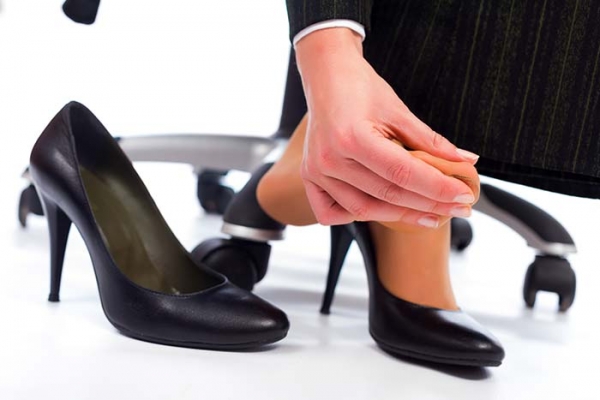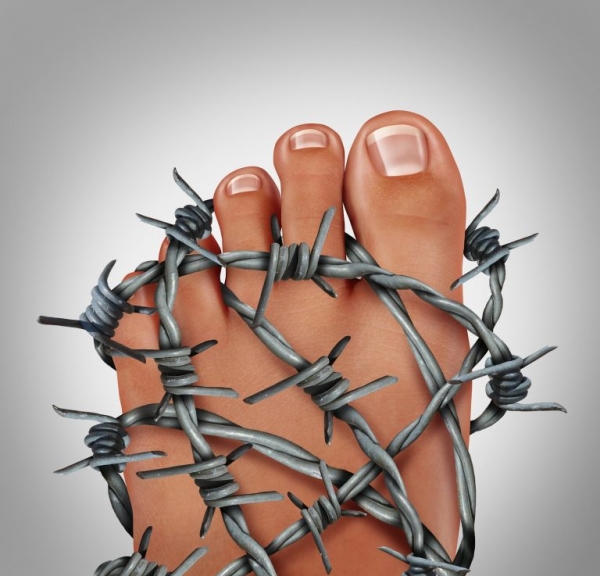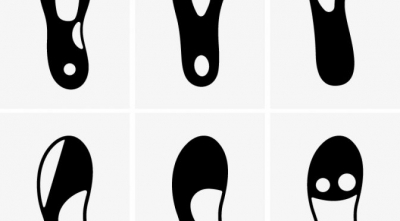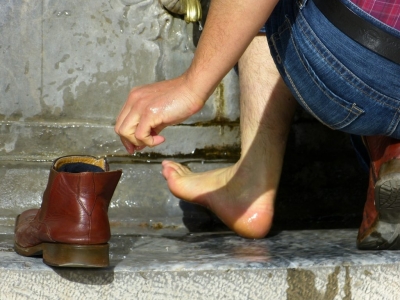Connect With Us
Blogs

Pain Relief (5)
Plantar Fasciitis: Causes and Treatment
Of the different types of pains occurring in the heel, plantar fasciitis is one of the most common. Its name derives from the area of pain and inflammation: a thick band of tissue called the plantar fascia, which runs across the bottom of your foot. Because the plantar fascia connects your heel bone to your toes, the stabbing pain or deep ache associated with the ailment generally occurs when you take your very first steps in the morning (the “morning hobble”) as the affected foot tries to heal itself in a contracted position through the night.
The pain associated with the plantar fascia normally lessens as your foot limbers up, although it may recur during the day, especially after a prolonged period of standing, or when getting up after having been in a seated position for a while.
Common Causes for Plantar Fasciitis
- Age. Plantar fasciitis is most common in active men and women between the ages of 40 and 60.
- Certain types of exercise. Activities that place repetitive stress on your heel and attached tissue, such as long-distance running, ballet dancing and dance aerobics on hard surfaces, can contribute to an early onset of plantar fasciitis.
- Faulty foot mechanics. Being flat-footed, having a high arch, or even having an abnormal pattern of walking can adversely affect the way weight is distributed when you’re standing and put additional stress on the plantar fascia.
- Obesity. Excess pounds put extra stress on your plantar fascia.
- Occupation. Factory workers, teachers, restaurant servers and others who spend most of their work hours walking or standing on hard surfaces have a higher risk of damaging their plantar fascia.
Importance of Treatment
If plantar fasciitis is left untreated, it may become a chronic condition. You may not be able to keep up your current level and range of activities, and you may even develop symptoms of foot, knee, hip and back problems because plantar fasciitis can affect the way you walk.
How to Cope with Plantar Fasciitis
Home Treatments
- Stay off your feet as much as possible
- Apply ice for 15 to 20 minutes, three to four times per day to reduce swelling
- Reduce or change your exercise routine
- Use arch supports in your shoes
- Do stretching exercises that stretch the Plantar Fascia
- Use anti-inflammatory medication such as Ibuprofen
Medical Treatment
If home treatments fail to bring relief to the plantar fascia, your doctor may opt for an injection of a corticosteroid directly into the damaged section of the ligament, which can help. A procedure that doctors can carry out in their office, they may use an ultrasound device to first determine the best injection site. They may also apply corticosteroids to the skin of your heel or the arch of your foot, followed by a painless electrical current to let the steroid pass through your skin and into the muscle.
Physical therapy can act as ongoing prevention for plantar fascia pain. A physical therapist can also show you exercises to strengthen your lower leg muscles, helping to stabilize your walk and lessen the workload on your plantar fascia.
Prevention for Plantar Fasciitis
To prevent plantar fasciitis, reduce the amount of time spent standing on a hard surface. Exercise on soft surfaces whenever possible, and visit a specialist to make sure you’re wearing the proper shoes for your foot type and gait. It is also beneficial to stretch the plantar fascia regularly. While it’s typical to experience pain in just one foot, massage and stretch both feet first thing in the morning, and three times during the day. It is especially important to stretch adequately before your exercise routine.
Stretching Exercises for the Plantar Fascia
Sit down, and place the affected foot across your knee. Using the hand on your affected side, pull your toes back toward your shin until you feel a stretch in your arch. Run your thumb along your foot–you should feel tension. Hold for a count of 10. Do this stretch first thing in the morning and at least three times during the day and before exercising.
Book an Appointment with Dr. Vikki and Dr. Connie
If you suspect you’re suffering from plantar fasciitis, be sure to get in contact with Dr. Vikki and Dr. Connie. They can help you get to the bottom of your foot pain problem and provide you with the right treatment plan.
What Is Morton’s Neuroma?
Unlike most neuromas, Morton’s Neuroma is not a tumor. It is a benign build-up of tissue surrounding a nerve, which can cause pain and discomfort. Many people describe it as the sensation of having a rock in their shoe, while others describe it as a painful burning or numbing sensation upon bearing weight.
The sensations are most often triggered on the ball of the foot between the third and fourth toes. Even the smallest amount of weight pressing down on the foot can cause discomfort.
On a microscopic level, deterioration of the affected nerve can be detected, though there are usually no abnormalities visible to the naked eye. Dr. Vikki and her team at the Superior Foot & Ankle Care Center can not only provide a sound diagnosis, they can provide the level of care required to dramatically increase patient comfort and mobility.
Causes of Morton’s Neuroma
Morton’s Neuroma is often linked to wearing high heels, as well as to various forms of exercise. Women and runners are most likely to suffer from it due to the confining nature of high heels and running shoes. Existing issues such as hammertoes or bunions can also cause or exacerbate the condition.
Symptoms tend to appear slowly, beginning most often with pain upon wearing restrictive footwear. Removing the constrictive footwear should alleviate the symptoms temporarily, especially in conjunction with mild massaging, but overtime the symptoms will worsen, lasting for up to several weeks.
As the condition continues to develop, the damaging effects of the neuroma will become less and less reversible. Early action is the best defense against permanent pain and discomfort. The earlier the diagnosis, the more likely that more invasive treatment such as surgery can be avoided.
Treatment for Morton’s Neuroma
Many conditions can present similar symptoms to those of Morton’s Neuroma. Only a professional, highly skilled team like the professionals at Superior Foot & Ankle Care Center can identify the source of the problem and provide the proper treatment.
The most common treatments are corticosteroid injections and orthotics, but various other forms of treatment exist including radio frequency ablation and Sclerosing alcohol injections.
While non-invasive methods of treatment are more common, in some cases, surgery is required. A neurectomy is performed where the affected tissue is removed. In recent years, ultrasounds have become instrumental in diagnosing Morton’s Neuroma, and in assisting with treatments.
There are no effective at-home cures for Morton’s Neuroma. But there are a few things you can do to help alleviate some of the symptoms:
- Insoles are a good place to start. Custom-fitted insoles can help to alleviate the symptoms by taking weight off of the affected areas. They are only effective on symptoms, but they can provide quick relief.
- Applying an ice pack to the affected area can cut down on the swelling and provide a soothing sensation when the pain is most acute.
- A proper diet is key when dealing with issues like Morton’s Neuroma. As neuromas are triggered by weight distribution, lessening the amount of weight your feet have to bear is always a good place to start.
- Cutting back on physical activity can help to slow the progression of the condition.
- Purchasing more supportive footwear with wider toe boxes and lower heals can help to remove pressure from the balls of the feet.
- Finally, basic over-the-counter anti-inflammatory medications such as Ibuprofen can help to alleviate the pain.
While these methods can help to alleviate the symptoms, however, they cannot attack the actual issue, which is the thickening around the nerve tissue.
Contact Dr. Vikki Today
With the resources of a renowned podiatry clinic, as well as the preventative measures favored by the staff at the Superior Foot & Ankle Care Center you can find both relief and the tools necessary to prevent future issues. Don’t waste another day in pain.
Schedule an appointment today to talk to the well-renowned team at Superior Foot & Ankle Care center, and get back on your feet.
It is very important to have shoes that have just the right amount of arch support, particularly for those who transition into boots during the winter time. Seasonal Footwear all have their own unique support issues. Most boots lack the cushion and support that sneakers have while summer sandals do not provide proper ankle support.
Wearing appropriately-fitted shoes is a key part of keeping your feet healthy and in working order. You need shoes with good arch support and stable shoes, but it can be difficult to find the footwear that provides the best orthopedic fit for your feet. Without proper arch supports you leave yourself open to developing pain in your heels, ankles, knees and even lower back.
Dr. Foley and Dr. Ornelas of Superior Foot & Ankle Center have compiled a list of shoes and shoe retailers that are best suited to prevent a variety of foot-related injuries and issues. This list separates shoes by athletic categories, such as running, cross-training, basketball, hiking and golf. To avoid these problems you should always find shoes that have just the right amount of arch support or else wear orthotic insoles.
Here’s some information about what orthotics are and what different kinds are available.
What are Orthotics?
Orthotics are inserts that correct a number of foot-related problems from flat feet to heal pain. While they do not fix any major biomechanical problems with your feet, they do provide relief for minor aches and pains.
Over the Counter Orthotics
There are a number of different kinds of over-the-counter orthotics that treat minor foot problems and alleviate pain. For example, arch supports can help correct fallen arches or flat feet while gel inserts help relieve foot and heel pain.
Prescription Orthotics
If you find that over-the-counter orthotics are not alleviating your pain, and it is best to consult a foot care professional about getting prescription orthotics. Prescription orthotics are high-quality inserts that address your specific foot care needs. These custom orthotics correct any number of serious foot problems from plantar fasciitis to abnormal motion. In addition, custom orthotics can relieve severe pain in your feet, knees, shins and back. They can even be used to help diabetic treat their painful foot ulcers and calluses. Prescription Orthotics are created by taking a mold or scan of your feet, so you know that your individual foot issues are being addressed.
Other Things You Should Know
You can find orthotics that are designed to fit and work inside high heel shoes.
Because over the counter orthotics can take a while to break in it is best to wear them around the house for a few days before wearing them to work. Many shoe brands come with extra padding and support. For example Cole Haan dress shoes and boots all come with Nike Air inserts.
Over the counter inserts can last anywhere from 3 months to a year, depending upon how much standing and walking you do at your job. For this reason, people with jobs that require a lot of standing and walking such as nurses and waitresses should have a spare pair of inserts just in case.
Now that you know the importance of having proper foot support in all of your shoes no matter what season it is, be sure to use orthotics to correct and prevent pain. If you are experiencing foot pain, no matter how minor, it is important to speak to a foot care professional as soon as possible to discuss ways to correct this issue. If you have any questions about orthotics; please feel free to contact us today to schedule a consultation.
Treating Your Blister
Although most blisters eventually heal on their own, the recovery time required isn’t a feasible option for those who are active or experiencing pronounced pain. It is important to know the right methods of treatment to remain healthy and to prevent your blister from getting worse.
What Causes a Blister?
Blisters occur when temperatures rise, causing the feet to swell and sweat. This results in additional friction formed between the feet and shoes, creating a fluid-filled sac around the affected area.
Treating An Unbroken Blister
The treatment method depends on where the blister is located and its level of severity. An unbroken blister or a blood blister will heal on its own. All that is required is a bandage to protect it, and avoidance of the activities which caused or may aggravate it.
For a small blister on a weight-bearing area (such as the heel, or the ball of the foot a doughnut-shaped felt pad should be applied. Leave the area above the blister open as much as possible.
In most cases, popping a blister at home is not advised. If it is too painful, however, follow these steps to drain it safely:
- Wash both your hands and the blister with soap and warm water.
- Swab the blister with iodine.
- Take a needle or a straight pin and wipe it with rubbing alcohol.
- Gently puncture the edge of the blister.
- Press the fluid toward the hole to drain it out.
Never drain a blister, no matter how small it may be, if the following is true:
- You have diabetes, cancer, HIV, heart disease, or another condition which increases the risk of infection.
- You have reason to believe that the blister was caused by a contagious disease, such as chickenpox. If you drain this type of blister, the virus may spread to other people.
Treating a Torn (Or Drained) Blister
Once the blister has torn or drained, follow these steps:
- Wash the area with soap and water – not alcohol, iodine, or any other cleanser.
- Leave the flap of skin over the blister, unless there is dirt or pus under it. Smooth the flap over the exposed layer of skin.
- Apply antibiotic ointment such as Bacitracin or Triple antibiotic ointment and then a clean bandage. If an itch or rash develops, discontinue the ointment, since there may be a skin reaction.
- Change the bandage whenever it becomes wet or dirty, and remove it every night so the affected area can dry. If you are going to remain active as the blister heals, you may find Band Aid blister cushions or 2nd Skin blister pads particularly helpful.
When To Call a Doctor
Call your doctor if the following occur:
Monitor the area closely for signs of an infection. These may include: increased pain, swelling, redness, or warmth surrounding the blister; red streaks extending from the blister; drainage of pus; or fever.
Call your doctor if you notice these symptoms:
- A crusty blister which drains honey-colored fluid.
- Signs of illness, such as shaking chills, fever, belly pain, vomiting, diarrhea, muscle or joint aches, headaches, or a vague sense of illness.
- Symptoms do not improve, or increase in severity and/or frequency.
Preventing Blisters
Since blisters are caused by the friction between your feet and your shoes, wear shoes that fit well. This means that you should be able to wiggle your toes inside the shoe. Your feet swell later in the day, so try on shoes in the afternoon or the evening.
Moisture-wicking socks help reduce the swelling of the feet and friction associated with blisters. There are other socks and insoles designed to prevent blistering as well.
Applying moleskin to an area of the shoe where your feet rub may also help. Dust the inside of your shoe with talcum powder.
Avoid contact with plants like poison ivy, oak, or sumac.
Avoid contact with people who have infections that can cause blisters, such as:
- Viral illness like chickenpox, shingles, genital herpes infection, and cold sores
- Bacterial skin infection
- Scabies mite infection
Ask the Expert
To learn more about keeping your feet healthy, read the 15 Steps to Fabulous Summer Feet.
For the best in foot care, schedule an appointment with specialist Dr. Vikki or Dr. Connie at the Superior Foot & Ankle Care Center today.
For many runners, hitting the pavement isn’t only a healthy form of exercise, it’s a passion and a way of life. However, no matter what the motivation behind the activity may be, the unfortunate fact is athletes are often prone to an onset of physical complaints, including foot problems, heel pain and other ailments.
Iliotibial Band Syndrome (ITBS), is one of the leading knee injuries that runners experience. It can impact activity levels and lead to disabling pain. Discovering more about this common injury and how to care for it can help keep runners on track…literally.
What is ITBS?
ITB Syndrome involves the iliotibial band, the ligament that runs from the hip to the knee, which helps to stabilize the knee and aid in joint movement. When friction of the ITB band on the side of the knee occurs, the result is inflammation and irritation. This causes sharp pain that is located on the outside of the knee. It may also include the following symptoms:
Swelling around the outside of the knee
Pain that increases with continued running or activity
Feeling the band “snap” as the knee bends and straightens
Feeling intense pains strike when knee is slightly bent
In some cases, pain and tightness at the outside of the hip
What Causes the Syndrome?
Classified as an overuse injury, ITB syndrome is caused by the repetitive bending of the knee. However, there are several different factors that can contribute to the knee pain and increase the chances a person will experience it. Common risk factors include:
- Overpronation of the foot
- Muscle imbalance
- Bowed legs
- Legs that are uneven in length or an uneven running stride
- Wearing worn-out footwear
- Running downhill
- Improper training techniques: too much too soon, insufficient warm-up before activity or not enough rest in between periods of exercise
What Can Be Done For Care & Treatment?
If nothing is done to take care of ITBS, the pain can become chronic and bring activity to a halt. There are several things that can be done to alleviate the pain and prevent the problem from worsening.
Resting is perhaps the most obvious form of care. For runners, it may be one of the most difficult. Running less often and/or shorter distances should be done to allow the ITB band time to heal. However if pain continues, running should be stopped completely, and another treatment pursued. Other methods for caring for ITBS may include:
Ice – Applying ice to the area can help reduce inflammation and pain. This can be done for a length of about 15-20 minutes or until pain diminishes.
Orthotics – Visiting with a podiatrist and possibly having footwear fitted for orthotics can help to ensure proper support.
Stretches – Regularly doing side stretches that stretch the ITB band and hip muscles are helpful for treatment and preventative measures.
Roll It Out – Using a foam roller can work to stretch out the ITB band and act as a deep tissue massage. This can be done by sliding down on one’s side and putting the foam roller under the leg. Next, roll the foam from the hip to the knee using the pressure of body weight.
Strengthening Exercises – Performing lower body exercises like squats and lunges can help build up weak butt and hip muscles. These weak muscles may be contributing factors to the syndrome.
In certain cases, a doctor may recommend additional treatment options such as medication and electrotherapy. Surgery is another option, but it is only performed as a last resort.
The most important thing is that something should be done to care for ITBS in order for runners to once again tackle a path without pain. If you need to be fitted for orthotics, or have another foot issue, contact Super Foot & Ankle Care Center in Long Beach. Our experienced podiatrists and staff are dedicated to helping patients achieve proper foot health in order to get back to being active in the things they love in life.





